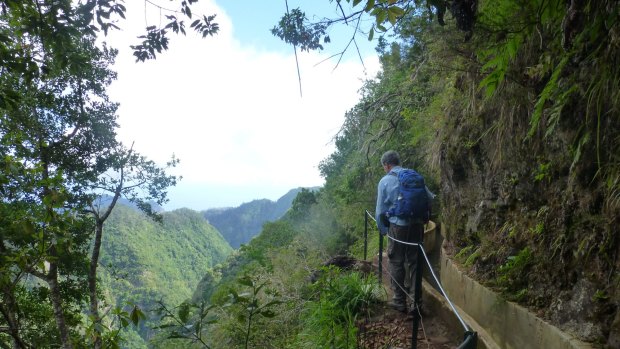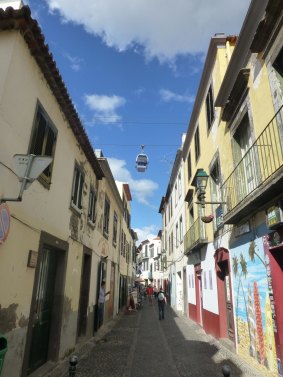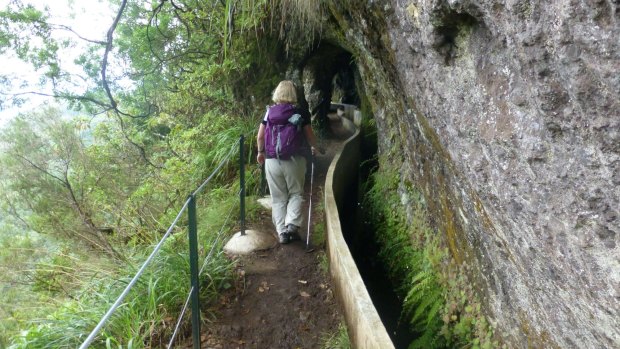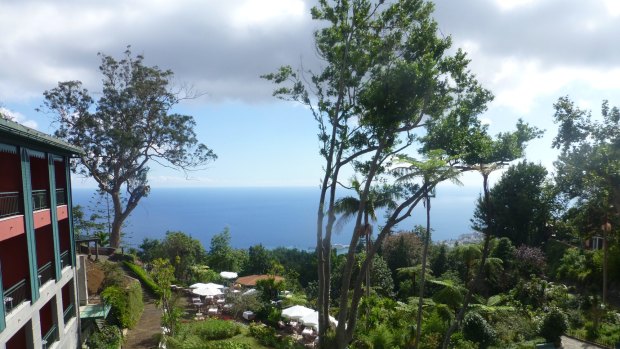This was published 9 years ago
Madeira, Portugal: The walkers' paradise
This walkers' paradise will leave you stunned and breathless - and not just because of the views, writes Alison Stewart.
By Alison Stewart

Highlight: A hiker negotiates his way along the steep-sided Ribeiro Frio levada.Credit: Rob Mills
My friend stands immobile on the slippery rock ledge. Below, the ground plunges into an abyss. Above, a giant boulder teeters. She's in the grip of vertigo and her partner must inch forward and guide her to safety.
Our narrow "path" hugs one of Madeira's 2000-plus kilometres of levadas. These remarkable stone irrigation channels have been hand-hewn into often precipitous mountainsides to bring water from the high north to the south's agricultural terraces. Many lives were lost as workers were suspended in wicker baskets to cut the rock.
Now, they are a walkers' paradise. True, they can be perilously narrow and slippery, those tree falls and boulder landslips must happen sometime, and hypothermia lurks if the island decides to behave like an island and you come unprepared.

The cable car from the city to Monte passes over the old town of Madeira’s capital, Funchal.Credit: Rob Mills
On the plus side, the levada paths are magical corridors into the heart of this World Heritage-listed Atlantic island. Like hobbit tracks, they guide you through a variety of landscapes from native laurilsilva, pine, chestnut, cedar, cypress and oak to exotic terraces of flowers and fruit, moss-covered cliff faces and dells, sudden startling ocean vistas, moonscapes and serrated mountain peaks. The trick is to negotiate the island respectfully to avoid a more rapid mode of sightseeing.
Madeira, known as the Pearl of the Atlantic or the Floating Garden, inhabits an exotic location 'twixt Africa and Europe, mid-Atlantic, like a small rogue planet in deep space. Part of the Macaronesian archipelago, Madeira is only 600 km off the Moroccan coast, the same latitude as Marrakech. It's Portuguese, but its culture is both European and African.
The island rose from the ocean 20 million years ago, its volcanoes spewing lava. That fertile volcanic basalt, plus a happy combination of temperate and subtropical climates has fashioned a fairytale emerald-green isle whose beauty comes with just a hint of danger, as all fairytales do.

Hitting the trail: Entering the levada rock tunnels.Credit: Rob Mills
The levadas can be dangerous. The last death was in June, when a German tourist fell 20 metres. Care is needed; walkers should be fit enough, should avoid the riskier levadas if suffering vertigo, take adequate water, food, warm and waterproof clothing, torches for the levada tunnels and decent hiking boots.
Our foursome doing Inntravel's Waterways and Flowers seven-day independent walk inhale our own special whiff of danger. I slip on a muddy levada path and luckily it's only my camera that plunges over the cliff. Our friend trips on a rock and hurtles towards a precipice. Even our luggage joins in. An adventurous suitcase escapes from the taxi boot and barrels downhill, getting more than it bargained for when the driver reverses into it.
And flying in engenders its own frisson of fear. First, the vivid Jurassic Park-esque island looms into view, rising from the seabed 5000 metres down; its highest peak, a majestic 1862 metres. Then you spot the runway – a virtual carpark tacked to the side of the cliffs. A nervous scatter of applause accompanies our landing.

Bonny balcony: Quinta do Monte has stunning views.Credit: Rob Mills
But things are looking up. The runway has been extended twice since a Boeing 727 plunged off the end in the 1980s. And two of Madeira's most gorgeous, yet treacherous walks have been upgraded with strong railings.
I should also mention that dengue fever broke out in 2012, mostly around the capital, Funchal. It has not recurred but visitors should take mosquito-repellent.
Thanks to Inntravel's copious briefing notes, we're clued up on all things Madeiran. We also love that we only stay at three hotels, meaning we can settle in and explore three discrete areas – the coastal north-west, the high country and the southern city of Funchal. And because Madeira is so mountainous and the levadas occur at higher altitudes, we are mostly driven to the start of the walks, thus reducing climbs and descents. Our luggage is transported and we carry only day packs.
The charming village of Porto da Cruz is where we begin, staying at the family-run Costa Linda, perched so close to the ocean you can see the fish jumping and hear the crack of rollers as they strike the base of Penha D'Aguia, the weird 590-metre bluff-shaped volcanic plug that towers over the village.
Costa Linda, with its incredibly helpful duo of Lucrecea and Claudia, is where we get our first taste of traditional Madeira food – scabbard fish espada served with a grilled banana, beef espetada barbecued over charcoal, caramujos or tiny sea snails you winkle out with a pin, lapas or limpets and bolo de caco, traditional round flat bread with garlic butter.
We also sample the immature and dirt-cheap Vinho Americano at the local bar. How to be tactful? Rough as guts. We revert quickly to Madeiran grenache. The better-known fortified Madeira came about accidentally when sailors discovered wine improved dramatically on the high seas. Merchants paid high prices for this shaken-about "round-trip" wine. Today, the process is reproduced by heating before maturation.
Our first 15-kilometre walk out of Porto da Cruz takes us along the Castelejo and Referta levadas into the unspoiled, deep-cut valley of the Ribeira de Sao Roque.
To reach the levadas, we must ascend sharply through verdant terraces. I suspect if you throw down a pip, a tree will instantly sprout. Around every corner monster melons, figs, avocadoes, passionfruit, giant beans and tomatoes, chestnuts, bananas, grapes, loquats, custard apples, pawpaws shoot up. A veritable United Nations of plants grows along a short stretch of levada – English oak, Mexican and Norwegian pine, Australian acacia and Tassie blue gum, New Zealand flax, Indian loquat, South African agapanthus and Madeira laurel.
Madeira means "wooded" from the dense cover of ancient trees that confronted the Portuguese explorers in 1419. This rich biodiversity means UNESCO classified it World Heritage in 1999. The early explorers set the laurel alight for sugar cane, but the remaining forest is one of Portugal's seven natural wonders and regrowth is encouraged.
The Sao Roque valley becomes challenging, the levada path narrowing with slippery clay and minimal hand holds. We reluctantly turn back, accompanied by the constant song of running water that provides natural air-conditioning during heat-of-the-day siesta. We've only had to use the phrase: "Estamos perdidos" (We're lost) two, maybe three times.
We depart Porto da Cruz the next day for the mountains, our driver dropping us 490 metres up at Portela. Today we walk up to Santo da Serra at 700 metres, the vegetation and topography frequently changing from natural laurilsilva, indigenous ericas and yellow gorse to coniferous cedar, juniper and cypress. Ever-present are the agapanthus and hydrangeas which line some levadas, while other colourful exotics such as brunfelsia perfume the air.
This is the day my camera goes for six and our designated leader takes his eye off the ball and leads us past the summit of Pico do Suna, prompting a minor marital spat.
We love Santo da Serra's rolling green hillsides. This is where Funchal's wine merchants built their summer retreats and quintas (elegant country houses) abound. Our three-day stay at a renovated 1920s country house, the Porto Bay Serra Golf, is a highlight, for its excellent meals (wonderful coq au vin served in little cast iron pots), high teas with scones and Madeira cake and the two walks mentioned earlier. Plus we have arrived during cider (sidra) festival and the flower-festooned valleys ring with song.
Today's 16-kilometre walk from Ribeiro Frio back to Santo da Serra with a side trip to the Balcoes Belvedere is probably our favourite. We pass through small tunnels cut into the cliff face and cathedral rock passages requiring torches. In parts the paths are ridiculously narrow with hairy drops but the views! There are mossy banks with water trickling from the peaks, belled goats, swathes of laurel forest with the central mountain chain like a dragon's back above. Endemic species like orchids, geraniums, Madeira groundsel and moneywort provide splashes of colour in the green forest. I feel another adjective coming on: breathtaking.
The next day, we're in a different country. The Sao Lourenco Peninsula offers up a moonscape of ochre and grey geomorphology – hard basalt, dikes, volcanic ash mixed with calcareous sand and sandstone, multi-coloured sea cliffs. This walk has gasp-worthy plummets, including a land bridge only a metre or so wide with 100 metre drops. The new stout wire barriers help with vertigo. A bit. It's stinking hot and we gratefully sink into the water off a rocky beach, then devour our picnic surrounded by prehistoric skinks.
The final walk through oaks, beech, chestnut, pines and eucalypts takes us 16 kilometres from Rochao to Monte perched 560 metres above Funchal for our last two nights. Once a grand mansion, Quinta do Monte was the final home of the exiled Austro-Hungarian emperor, Charles I. Our balcony has views over lovely gardens, down to Funchal, whose historic centre we spend time exploring, taking advantage of the 3.7-kilometre cable car from Monte to the city.
Quinta do Monte belongs to a group of historic quintas with a "dine around" option. Our tasting menu at Funchal's Quinta dos Vistas is a sophisticated distillation of island produce, miniature explosions of Madeiran flavour and afterwards as the city lights glow beneath us, we toast a remarkable seven days on this magical island.
The writer was a guest of Inntravel.
TRIP NOTES
MORE INFORMATION
inntravel.co.uk; madeira-tourist.com; smartraveller.gov.au/zw-cgi/view/Advice/Portugal
GETTING THERE
Emirates flies daily from Sydney and Melbourne to London Gatwick stopping in Dubai (23h25). Ezyjet flies most days from Gatwick to Madeira Funchal (3h45) See emirates.com/au; ezyjet.com
STAYING THERE
Inntravel's seven-night Madeira Waterways and Flowers independent walk includes ensuite accommodation, breakfast, five dinners, two picnics, bag transfers, airport and some other transfers, route notes and maps. From ₤622 a person twin share. See inntravel.co.uk/holidays/walking-holidays/Portugal/Madeira, phone +44 (0)1653 617001.
FIVE OTHER ATLANTIC ARCHIPELAGOS
The Azores (nine islands) – the northernmost Macaronesian islands. Choose San Miguel for volcanic scenery and whale watching, Furnas for hot springs, Pico for mountain climbs, Flores for volcanic lakes and flowers. See visitazores.com
Canaries (12 islands). Choose Tenerife for Mount Teide, the world's third-tallest volcano, rugged Gomera for dramatic mountain walks, Lanzarote and La Palma for beaches. See turismodecanarias.com/canary-islands-spain/
Cape Verde (10 islands) is the southernmost group. Santa Antao, the second largest island is renowned for valley and gorge hiking. See capeverde.com/
Porto Santo. Don't forget Madeira's second island, 43 kilometres north-east. Known for its ochre colouring and white-sand beaches, it could not be more different. See porto-santo.com/
The Selvagens are 300 kilometres south of Funchal. These Portuguese isles are seldom visited, isolated, recommended for nature and bird lovers. Madeiran company Ventura do Mar operates six-day charter boat tours. Also tours of Madeira's Desertas islands (home to endangered monk seals) to see birds and mammals. See venturadomar.com/services/aPpC9u3W; selvagens.seawatching.net/general.html
Sign up for the Traveller Deals newsletter
Get exclusive travel deals delivered straight to your inbox. Sign up now.